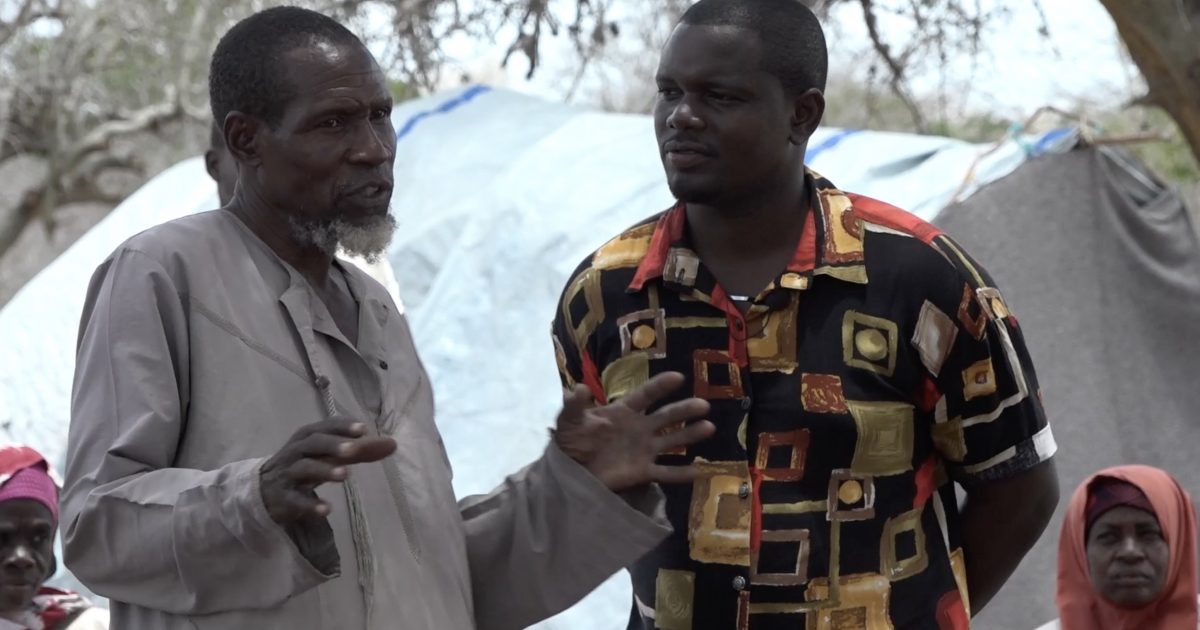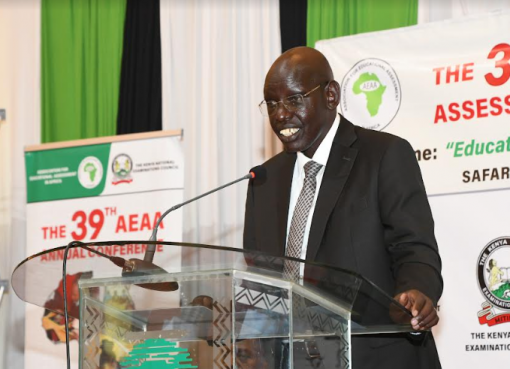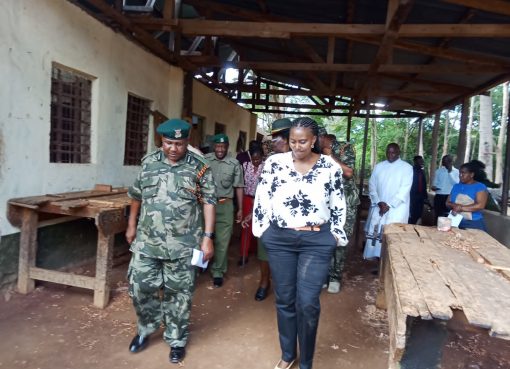It’s windy, and the heat is intense. In the shade of a tree with scanty leaves, a gathering of internally displaced persons (IDPs) convenes for a community dialogue meeting in one of the camps in Tana River County.
Community radio presenter, Kula Nzomo, works for Vox Radio 95.0 in Minjila. He hosts the Makala ya Tumaini show every Thursday from 7-10 pm. The station broadcasts in Swahili.
Nzomo and the station’s Manager, Ferdinand Muthui, are at the meeting. Community Health Promoters (CHPs) are present. Nzomo steers the agenda.
“Do you men experience gender-based violence?” he asks Ali Kombo, from Dumi camp, who has volunteered to step up. “Are you sometimes battered by your wives?” Nzomo presses the matter further.
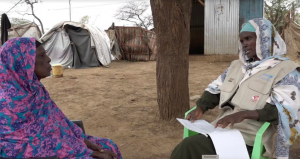
Kombo’s look is a mix of surprise and hesitancy to answer. He says, “Differences in families arise from time to time, and they are resolved through talking. I haven’t received many reports of domestic brawls.”
Torrential rains pounded several parts of the country in the March-April-May rain season this year.
According to the Kenya Red Cross 2024 Floods Update, 43 counties bore the brunt of the floods, causing 294 fatalities.
Infrastructure and property were damaged. Some 55,109 persons were displaced. While 288 IDP camps sprung up.
In this part of Tana River County, near Garsen, are seven camps inhabited by distraught individuals and families that have come to terms with their present lot in life.
They were dislodged from their homes by raging floods. Danisa Cluster, Danisa B, Danisa Chief’s Office, Mitapani, Gamba, Kijo Farm, and Bula Rahma camps have offered them refuge.
Close to 2, 000 people live in tarpaulin shelters being gnawed at by the elements insidiously.
These dwellings are among the 13, 064 non-food items distributed by aid agencies countrywide.
A platform to voice appreciation or grievances related to the heavy rains that fell in Tana River, Garissa Counties and elsewhere has been offered. The flooding was exacerbated by the fact that the Tana River basin is a conduit for floodwater drainage to the Indian Ocean.
Nzomo aims to sift through some issues that he would hear or observe to amplify them during his programme. The radio’s transmission covers Tana River, Kilifi, and parts of Lamu counties. Perhaps the national or county governments and aid agencies might catch the broadcasts and swing into auxiliary action to alleviate the plight of these victims.
“We come to these camps every week,” he says. “This is a central venue where residents from the other camps easily reach.
The Centre for Behaviour Change and Communication (CBCC) Africa, through UNICEF, has been implementing a community engagement strategy aimed at ensuring that affected communities have access to lifesaving information. Community radio stations fit the bill.
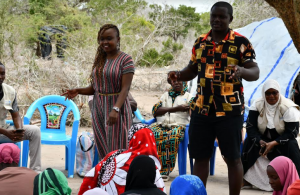
A CBCC Project Officer, Joshua Githinji, says the partnership with UNICEF deemed it fitting to pilot accountability to the affected population mechanisms at the community level among selected counties, and that’s why different interventions were established.
“We work with community health promoters to go around the villages targeting the people who were affected to share information and collect feedback,” he says.
Nzomo nudges women to open up and share their experiences regarding their lives in the camps. He exacts details about gender-based violence (GBV). No woman readily divulges if it takes place. Health, sanitation, and education, among other problems, are covered. As the crowd disperses to their tents, Nzomo knows the issues he’ll magnify.
The county department of health will have to be involved. “There’ve been cases of diarrhoea diseases in one of the camps. It’s not known if that’s due to the water they drink or the food they consume,” Nzomo says.
It would be apt to invite a medical practitioner to the broadcast sessions to address how best the families in the camps could tackle the health concerns raised.
The Sub-County Public Health Officer in Tana Delta, David Ndumari, says, “Most of the sanitary facilities were swept away by the raging waters, and so sanitation coverage went down.” He adds, “We had a lot of mosquitoes leading to vector-bone infections like malaria, diarrhoea, and cholera.” Cases of upper respiratory tract infections in the camps due to dust were also reported.
In as much as GBV matters are hushed up, the Community Health Assistant, Mariam Bassa, touches on it. “The first step is to take the individual to the hospital,” she says. “If it’s a rape case, the victim is taken for treatment. A P-3 form is obtained and filled out so that the court case can
Start off.”
The emergency structures housing families have neither windows nor doors. They are not lockable and therefore cannot keep intrusion at bay.
Another community radio station with a similar task to that of Nzomo’s is Kulmiye 90.9, located in Garissa Town. It broadcasts in the Somali language. Mustafa Hassan runs Makala Ya Tumaini, too.
After community engagement sessions, he says, “We try and contextualise that in a way that’s suitable for our radio station and also for the involved stakeholders that can help the camp victims.”
The programme has interactive segments. “During the Tuwajibike Tunawiri show that airs on Thursdays at 5 pm, we have options for call-in and SMS, where the survivors or other listeners can call in and share their feedback,” Hassan says.
The two radio stations, Vox and Kulmiye, play a central role in addressing preventive and promotional measures for the public’s health and safety. Since most areas were inundated with water in Garissa, just like in the Tana River, there was a potential health risk. Sub-County Medical Officer of Health in Garissa, Dr. Mohamed Ahmed, says, “There was a lot of contaminated water post the floods. We swung into action to ensure that we increase community sensitisation on how they should have their water treated, and practice general hygiene and sanitation. As a result, this was the first time that we mitigated cholera cases to less than two,” he says.
The Public Health Officer, from the Public Health Emergency Operations Centre, Paul Mwanzia, recalls how people were flashed out of their residences. The victims ended up in more than five IDP camps in Garissa. “We are better prepared for the next such incident should it arise.”
CHPs have been assigned more than 100 households to visit and collect data on various life aspects that the two radio journalists are interested in.
Due to the feedback gathered on the humanitarian aid, some positive results have been realized. One of the displaced persons, Jacob Ngala, says, “We got hold of the Governor and Senator after our cries were aired by Vox radio.”
One announcement regarding some aid meant for the displaced caught her attention and caught a Vox radio listener, Hamida Abdi, who said, “I heard, some of the victims will receive 20
roofing iron sheets per household.”
To authenticate what she heard, three truckloads of iron sheets and timber were being offloaded at Danisa Cluster camp from the Tana River County offices. The recipients were joyfully carrying the items away. Trains of little children had summoned their energies to ensure the planks of timber ended up at the intended stops.
CHPs have been out making follow-ups on affected individuals and families. One of these is Zahara Abdalla. She cares for more than 100 households.
Upon entering a homestead, she says to the householder, “I’ve visited you to collect your views on how the floods affected you and how you’ve been coping to date.” She then uses
predesigned probing questions to draw answers from her interviewees.
“I ask questions about their environment, sanitation, the health facilities they go to and how far they are, education, food, and nutrition, and if there’s any aid they’ve received and from whom?” she says. She enters into her manual’s appropriate columns the details provided.
A destroyed dairy structure is a stark reminder to Bahati Gakuya of how devastating the floods were. She’s now picking the pieces of her life up, having come to terms with the shock she suffered.
A pit latrine excavated by one of the aid agencies serves about 10 households. “I’m the one in charge of the latrine,” she says. “When it’s my turn to clean the latrine, I do it and remind my neighbours when their turn comes.”
A Community Health Officer at Police Line Dispensary Namha Mohamed, is aware of GBV. She says it’s not only women who are beaten by men. Some men are taken for treatment having been battered by their partners. We counsel them and advise them on how to live in peace. We then tell them where to report.”
According to Namha, the GBV unleashed upon men sometimes arises due to reasons beyond the men’s control.
A boda boda operator, for instance, might return home with either too little money or none at all having had a dry day. The woman may ask for money that hasn’t been earned yet, and on finding her man with nothing, she engages in combat.
It’s hoped that the populations that were dislodged from their homes, will receive a measure of relief from the distressful flooding they experienced.
By William Inganga


